Mission: Impact podcast & blog
Build a better world without becoming a martyr to your nonprofit cause
Listen on:
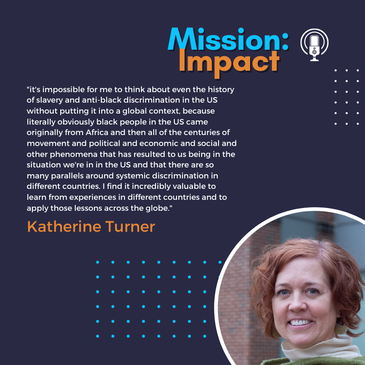 In episode 66 of Mission: Impact, Carol and her guest, Katherine Turner discuss:
Katherine L. Turner, MPH (she/elle) is the founding President of Global Citizen, LLC consulting firm that strengthens inclusive leadership and effects organizational transformation and social impact by advancing diversity, equity, and inclusion, public health, human rights, and global competence. As Adjunct Professor at UNC-Chapel Hill, she teaches and mentors global leaders on leadership, global competence, and other topics. Katherine provides strategic leadership on global advisory committees, has founded and led boards of directors of nonprofit organizations, and won awards for excellence in leadership, teaching, public health, and advocacy. She is an internationally-recognized executive consultant, coach, thought leader, speaker, author, and change agent who has worked in English, French, and Dutch across all sectors in over 50 countries to deliver high-impact results for a better world. Important Links and Resources:
Helping nonprofits boards move toward greater equity with Christal Cherry and Renee Rubin Ross8/23/2022
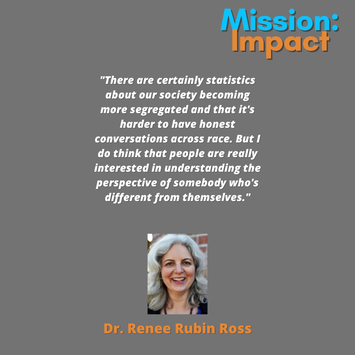 In episode 55 of Mission: Impact, Carol and her guests, Dr. Renee Rubin Ross and Christal Cherry discuss:
Guest Bios: Dr. Renee Rubin Ross is a nationally recognized strategic planning and board development consultant. Committed to racial equity in the nonprofit sector, Dr. Ross supports organizations and individuals in practices that celebrate and amplify diverse voices and perspectives. Christal M. Cherry is a nationally recognized nonprofit executive and professionally trained fundraiser. With over 20 years in the nonprofit sector, she has supported higher education institutions, human services organizations and faith-based missions. Her career portfolio, as a full time professional and consultant includes American University, the United Negro College Fund, Spelman College, Nicholas House, the Interdenominational Theological Center, Florida A & M University, Action Ministries, and the GA Center for Nonprofits. In each role, Christal has interfaced, guided and collaborated with diverse boards made up of college presidents, ministers and bishops, politicians, corporate CEO's, civic leaders, consultants, attorneys, stay at home moms and students. With passion and a wide breadth of experience, Christal works today with clients to help them mark a clear path to success in board development. Her style is electrifying, inspiring, and energizing. Christal earned a MA in Counseling from Hampton University, a BA in Liberal Arts from Hofstra University and professional development certifications in nonprofit leadership, social media fundraising, and nonprofit management. She currently serves on the board of the Greater Atlanta chapter of the Association of Fundraising Professionals and the Villages of Carver YMCA. She is regular presenter with CANDID, Qgiv, Network for Good, Bloomerang, and the Mississippi Alliance of Nonprofits and Philanthropy where she facilitates webinars and teaches courses in fundraising, board development and equity and inclusion. Christal has been a guest on multiple podcasts and enjoy serving as a requested expert on board matters. She is contributing author in Collecting Courage, a documenting of racism and survival by 14 accomplished Black fundraisers working across North America. She also enjoys her membership in the African American Development Officers Network, Toastmasters, and F3, Fabulous Female Fundraisers which she founded. Important Links and Resources:
Click "Read Morea" for Transcript: 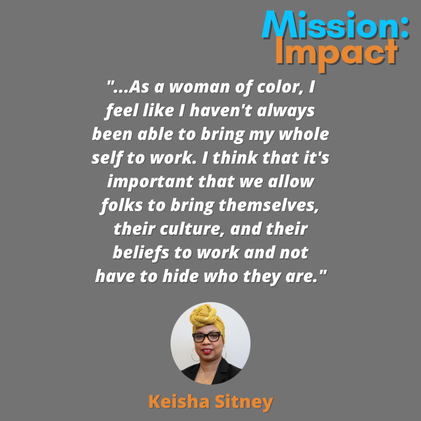 There is a brief discussion of police brutality in this episode around 16 minutes in. In episode 14 of Mission: Impact, some of the topics that Carol and her guest, Keisha Sitney, discussed include: - Why leaders need to be role models for their staff and lead by example - Why organizations need to start with individuals when working on equity - How to build the leadership capacity of people who haven’t traditionally been promoted to leadership roles - Why it is important to not just teach people of color to be like “traditional” white leaders but encourage them develop their own leadership style - How professionals focusing on diversity, equity, and inclusion experience profound fatigue in continually educating people about racism and other forms of oppression.
Keisha Sitney is the Chief People Officer for The Y in Central Maryland and the founder of Golden Key Coaching. She works to ensure the people strategies and resources support and match the strategic priorities of the organization. Keisha is an executive leader who has been with the Y for 30 years, both at the national and regional levels. With in-depth experience in coaching, talent management, strategic visioning and planning, and facilitation, Keisha has served in operational roles at the YMCA of Metropolitan Washington, led the national multicultural leadership development movement as well as served as an internal consultant for C-Suite leaders from Ys across the United States. She holds a Master's Degree in Organization Development from American University and a Bachelor's Degree in Psychology from Howard University. Links:
Click "Read More" for Transcript: 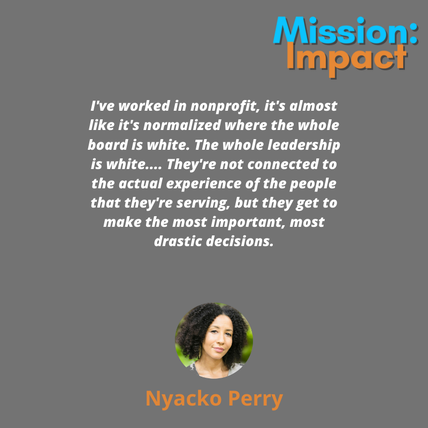 In episode 11 of Mission: Impact, some of the topics that Carol and her guest, Nyacko Perry, discussed include:
Additional Resources:
BoardSource 2017 research on demographics of nonprofit organizations - Leading with Intent report. Guest Information: Nyacko Perry utilizes a systems-thinking approach to assist individuals, community groups, and organizations, in creating more inclusive cultures. Her decade long career as a transformational change agent includes national and international facilitation with non-profit, corporate, and government agencies. Nyacko is the founder of Yin Consulting, a collaborative focused on personal, organizational and systemic healing. She is the Organization Development Partner at the much-anticipated Comfort Kitchen, a restaurant, community meeting space, and a food incubator dedicated to fostering collaboration, cross-cultural understanding, and community engagement. Nyacko also serves as a member of the Advisory Board for the Action Boston Community Development, Inc. Roxbury/N. Dorchester Opportunity Center. Nyacko holds an M.S. in Organization Development, with distinction, from American University. She is also a 500-hour professional level yoga teacher, an Afro Flow Yoga® certified teacher, and weaves her mindfulness expertise into her consulting work. Links:
Click "Read More" for transcript: 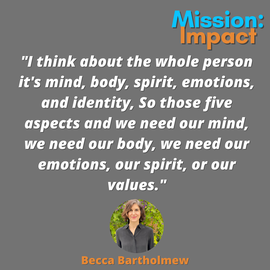 Episode 08: This week we’re talking to Becca Bartholomew. We talked about: • Ensuring all voices are included in planning processes • Why it is important for leaders to not only have intelligence but also have emotional intelligence and somatic intelligence • What the buffering sign on your computer has to tell us about today’s work environment Barry Oshrey’s Tops, Middles and Bottoms Ladder of Inference: Your Body is Your Brain by Amanda Blake A facilitator and coach with expertise in organization development (OD), Becca has extensive experience working with groups and individuals to foster communication and effective collaboration among diverse stakeholders. Becca helps her clients implement strategies that increase their emotional intelligence and efficacy. She is known for her clear communication, innate ability to foster trust, and firm, yet gentle approach to helping others recognize their blind spots and engage specific tools to articulate and reach their goals. She gracefully supports her clients toward self-reflection, new learning and increased awareness of their impact on others. She works with leaders of all types and has a special passion for those newer to leadership as well as those who hold societal privilege and want to address their roles in upholding and then dismantling systems of oppression. Links: https://www.linkedin.com/in/beccabartholomew https://twitter.com/thebeccab Click "Read More" for Transcript |
Archives
April 2024

Grace Social Sector Consulting, LLC, owns the copyright in and to all content in and transcripts of the Mission: Impact podcast, as well as the Mission: Impact blog with all rights reserved, including right of publicity.
|
Telephone301-857-9335
|
info[at]gracesocialsector.com
|
Grace Social Sector Consulting, LLC, owns the copyright in and to all content in, including transcripts and audio of the Mission: Impact podcast and all content on this website, with all rights reserved, including right of publicity.
|